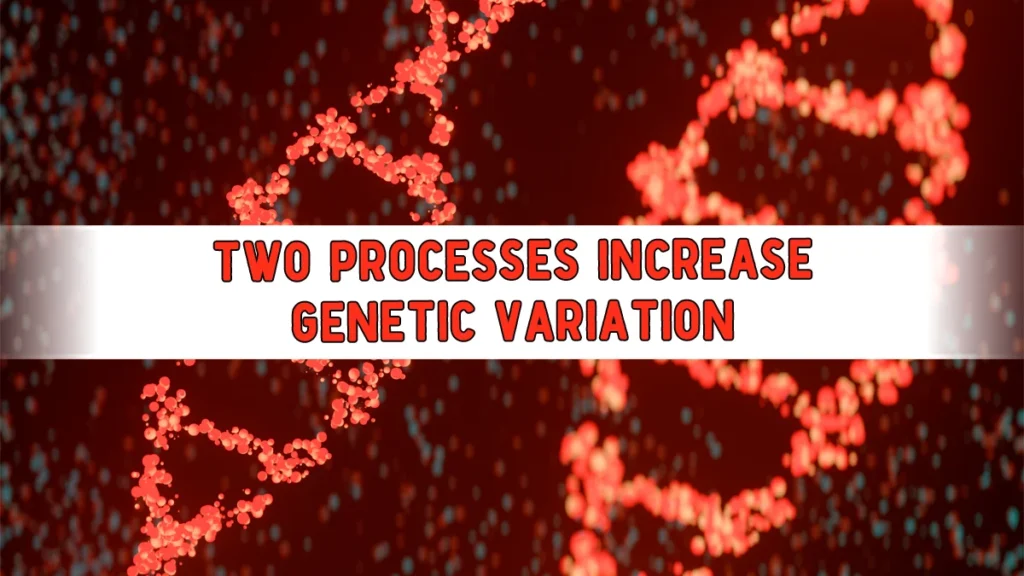Discover the vital processes that increase genetic variation. Unravel the mechanisms behind genetic diversity and their significance.

Introduction
Unlocking the secrets of genetic variation sheds light on evolution, adaptation, and the resilience of species. But what are the two fundamental processes that drive this diversity? Delve into this article to explore these mechanisms and their profound implications.
Which Two Processes Increase Genetic Variation?
Genetic variation, the cornerstone of biodiversity, arises from two pivotal processes: mutation and recombination.
Mutation: The Seeds of Diversity
Mutation, the spontaneous alteration in the DNA sequence, serves as nature’s creative force. These genetic mutations can occur due to various factors such as environmental exposure, replication errors, or external influences. Despite often being associated with negative connotations, mutations are the driving force behind genetic innovation and diversity. Through mutations, new alleles are introduced into populations, fostering genetic heterogeneity. This diversity provides the raw material for natural selection to act upon, ultimately driving evolution.
Recombination: Nature’s Genetic Shuffler
Recombination is nature’s ingenious way of shuffling the genetic deck. During sexual reproduction, genetic material from two parent organisms combines to form offspring with unique genetic compositions. This process occurs through the exchange of genetic material between homologous chromosomes during meiosis. By creating novel combinations of alleles, recombination generates genetic diversity within populations. Moreover, it facilitates the removal of harmful mutations and the preservation of beneficial ones, thereby contributing to the adaptive potential of species.
Understanding the Significance
The dynamic interplay between mutation and recombination is crucial for the survival and evolution of organisms. These processes not only foster genetic diversity but also confer resilience to environmental challenges. By generating a pool of genetic variants, organisms can adapt to changing conditions, evade pathogens, and thrive in diverse ecosystems. Furthermore, genetic variation underpins the health of populations, enhancing their ability to withstand disease outbreaks and environmental stressors.
Exploring Real-World Examples
To grasp the significance of mutation and recombination, let’s delve into real-world examples across different organisms.
- Bacteria: Rapid mutation rates in bacterial populations facilitate their adaptation to antibiotics, leading to the emergence of drug-resistant strains.
- Plants: Recombination during plant breeding programs creates new crop varieties with improved yield, disease resistance, and environmental tolerance.
- Animals: Genetic diversity within animal populations enhances their ability to survive and reproduce in changing habitats, safeguarding against extinction risks.
Our Other Latest Articles
Frequently Asked Questions (FAQs)
How does it increase genetic variation?
Genetic variation increases through processes like mutation, recombination, and gene flow, which introduce new alleles or shuffle existing ones, thereby enhancing genetic diversity.
What increases and decreases genetic variation?
Mutation, recombination, and gene flow increase genetic variation by introducing new alleles or shuffling existing ones. Conversely, genetic drift and natural selection can decrease genetic variation by favoring specific alleles over others.
Which process increases genetic variation?
Mutation is the primary process that increases genetic variation by introducing new alleles into a population’s gene pool. Additionally, recombination and gene flow also contribute to increasing genetic diversity by shuffling existing alleles or introducing new ones from different populations.
What are the long-term implications of limited genetic variation?
Limited genetic variation can increase the susceptibility of populations to diseases, environmental stressors, and other adverse conditions, potentially leading to population decline or extinction.
Can genetic variation be artificially manipulated?
Yes, through selective breeding, genetic engineering, and other biotechnological approaches, genetic variation can be manipulated to achieve desired traits in organisms.
How does genetic variation impact species conservation?
Genetic variation is crucial for species conservation as it enables populations to adapt to changing environments and reduces the risk of inbreeding-related problems.
Are mutations always harmful?
While some mutations can be detrimental, others may confer beneficial traits that enhance an organism’s fitness in specific environments.
What role does recombination play in evolution?
Recombination generates genetic diversity by shuffling alleles, facilitating adaptation and enhancing the adaptive potential of species.
Te Mend Final Thought
In conclusion, the intricate interplay between mutation and recombination is essential for fostering genetic variation, driving evolution, and ensuring the survival of species. By understanding these fundamental processes, scientists can unravel the mysteries of biodiversity and devise strategies for conservation and sustainable living in an ever-changing world.
“Good news! Te Mend is now available on WhatsApp & Telegram Channels. Subscribe today through the link and stay updated with the latest news!” Whatsapp & Telegram




